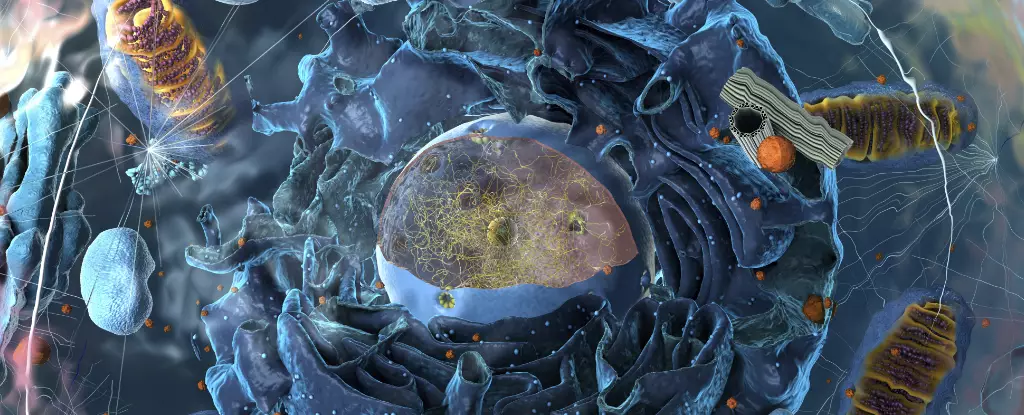For many of us, high school biology served as a gateway to understanding the intricate world of life at the cellular level. We memorized diagrams that showcased organelles—the various “organs” of a cell—surrounded by membranes, each serving unique functions essential for the cell’s homeostasis. Mitochondria were celebrated as the powerhouses generating energy, lysosomes as the recyclers of cellular waste, and the nucleus as the vault of genetic information. Despite our foundational knowledge, scientists’ views on cellular organization began evolving dramatically in the mid-2000s with the discovery that not all organelles fit the traditional mold.
In this shifting paradigm, membraneless organelles, now referred to as biomolecular condensates, have come to the forefront. These innovative structures are not encapsulated by membranes like their classical organelle counterparts. Rather, they form through a process that can be likened to the mesmerizing behavior of a lava lamp, where blobs of wax merge, split, and recombine. Within a cellular context, these condensates arise from proteins and RNA molecules clustering together, creating gel-like droplets that form a distinct microenvironment tailored for specific biochemical processes. As of 2022, researchers identified around 30 different types of these biomolecular formations, surpassing the mere dozen known membrane-bound organelles.
Despite their intriguing formation, the biological functions of biomolecular condensates remain elusive for many. Some, like stress granules and ribosomes, have well-known roles, while others lack clear functionality. The ubiquity of these condensates suggests that they may operate as multifunctional biochemical hubs, challenging the traditional view that membrane-bound organelles are the primary players in cellular function. This realization has prompted a reevaluation of existing models of cellular biology, indicating that there may be a wealth of uncharted functions tied to these membraneless organelles.
A pivotal concept in biochemistry has long been that a protein’s structure dictates its function—a mantra firmly established since the discovery of myoglobin’s structure in the 1950s. However, biomolecular condensates complicate this narrative. Many proteins contributing to these condensates possess regions devoid of a defined structure, known as intrinsically disordered proteins (IDPs). First documented in the 1980s, these curious proteins left scientists puzzled regarding their functionality without a solidified form. Eventually, it became clear that the formation of condensates was a crucial role for IDPs, unearthing a new layer of complexity in protein biology.
Traditionally, prokaryotic cells were perceived as the simple constituents of life, void of complex organelles. However, the discovery of biomolecular condensates in bacterial cells has revolutionized this view. Although only a small proportion of bacterial proteins share the disordered characteristics seen in eukaryotic cells, the identification of condensates within prokaryotes suggests these microorganisms possess a level of sophistication previously underestimated. These condensates perform an array of functions, from RNA synthesis to degradation, indicating that prokaryotic cells are indeed intricate entities.
The findings surrounding biomolecular condensates are not only reshaping our views on cellular structure but are also rewriting the narrative of life’s origins on Earth. Traditionally, it was believed that cellular life began within lipid membranes, a notion that inherently posed challenges based on the availability of lipid-forming materials in the primordial environment. However, recent insights that RNA molecules can gather into biomolecular condensates make it feasible for early life forms to emerge without the necessity of membranes. This revelation provides compelling support for the RNA world hypothesis, positing that life could have initially arisen from simple chemical precursors undergoing self-organization.
As researchers delve deeper into the realm of biomolecular condensates, there are promising avenues for understanding human diseases, including neurodegenerative disorders such as Alzheimer’s and Huntington’s. Scientists are exploring innovative strategies for manipulating these condensates, potentially leading to groundbreaking therapies that enhance or dissolve these cellular structures. Although the implications are still unfolding, the potential for advancements in both understanding cell biology and developing medical treatments is vast.
As the study of biomolecular condensates continues, there’s little doubt that our understanding of cell biology will evolve further, eventually finding its way into the curriculum of future biology classes. If each condensate is indeed assigned a specific function, students may have even more complex yet fascinating concepts to explore. With these evolving paradigms, the landscape of biological science holds exciting possibilities that challenge established concepts and ignite curiosity about the life that surrounds us.


Leave a Reply